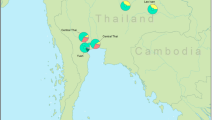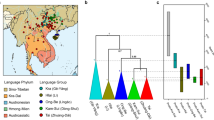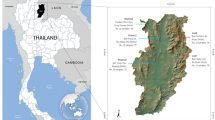Abstract
The Kra–Dai linguistic family includes Thai and Lao as well as a great number of languages spoken by ethnic minorities in Southeast Asia. In Thailand, a dozen of other Kra–Dai languages are spoken in addition to Thai, the national language. The genetic structure of the Kra–Dai-speaking populations in Thailand has been studied extensively using uniparentally inherited markers. To extend this line of genetic investigation, this study used 15 autosomal microsatellites of 500 individuals from 11 populations, belonging to nine Kra–Dai ethnicities, namely, the Kaleung, Phu Thai, Saek, Nyo, Lao Isan, Yuan, Black Tai, Phuan and Lue. These ethnolinguistic groups are dispersed in three different geographic regions of Thailand, that is, Northern, Northeastern and Central. The results show a very low average of pairwised Fst (0.0099), as well as no population substructure based on STRUCTURE analysis, indicating genetic homogeneity within the Kra–Dai-speaking group, possibly owing to shared linguistic ancestry. The Mantel test, an analysis of molecular variance, and the approximate Bayesian computation procedure employed to evaluate potential factors for driving genetic diversity revealed that language is the predominant factor affecting genetic variations, whereas geography is not. The result of distance-based clustering analyses and spatial analysis of molecular variance revealed genetic distinctions of some populations, reflecting the effects of genetic drift and gene flow on allele frequency within populations, in concordance with the result of R-matrix regression. The genetic and linguistic affiliations of the contemporary Kra–Dai-speaking groups are consistent with each other despite certain deviation due to various evolutionary factors that may have occurred during their migrations and resettlements.
Similar content being viewed by others
Log in or create a free account to read this content
Gain free access to this article, as well as selected content from this journal and more on nature.com
or
References
Li, F. K. in Culture in History: Essays in Honor of Paul Radin (ed Diamond S) 951–959 (Columbia University Press, New York, NY, USA, 1960).
Li, F. K. Handbook of Comparative Tai, (University of Hawai'i Press, Honolulu, HI, USA, 1977).
Pittayaporn, P. Proto-Southwestern-Tai revised: a new reconstruction. J. Southe. Asian linguistic Soc 2, 121–144 (2009).
United Nations, Department of Economic and Social Affairs, Population Division. World Population Prospects: The 2012 Revision, Volume II, Demographic Profiles (ST/ESA/SER. A/345) (2003) http://esa.un.org/wpp/documentation/publications.htm Accessed 10 September 2014.
Smalley, W. A. Linguistic Diversity and National Unity: Language Ecology in Thailand, (University of Chicago Press, Chicago, IL, USA, 1994).
Ongsakun, S. Prawattisat Lanna (Lanna history) 2nd edn (Amarin, Bangkok, Thailand, 1996).
Saraya, D. (Sri) Dvaravati: the Initial Phase of Siam’s History, (Muang Boran Publishing House, Bangkok, Thailand, 1999).
Wyatt, D. K. Thailand: a Short History, (Silkworm Books, Bangkok, Thailand, 1984).
Penth, H. A Brief History of Lanna: Civilizations of North Thailand, (Silkworm Books, Chiang Mai, Thailand, 2000).
Pittayaporn, P. Layers of Chinese Loanwords in Proto-Southwestern Tai as evidence for the dating of the spread of Southwestern Tai. Manusya. J. Humanities 20, 47–68 (2014).
Malasam, S. Khon Yong Yai Phaen Din (The Yong’s exodus), (Thammasat University Press, Bangkok, Thailand, 1997).
Sae-Ngove, S. & Mesathan, W. Thai Lue. Nakhon Pathom, Thailand, Encyclopedia of ethnic groups in Thailand, (Institute of Language and Culture for Rural Development, Mahidol University, 1998).
Kaise, R. Tai Yai Migration in the Thai-Burma border area: the Settlement and Assimilation Process 1962-1997, (M.A. thesis, Chulalongkorn University, 1999).
Duangthima, W. The Conservation of Tai-Khuen Community in Ban San Kangpla, Chiangmai Province, (M.A. thesis, Chulalongkorn University, 2005).
Eam-eium, C. A Phonological Description of Phuan at Tambon Hat Siaw, Si Satchanalai District, Sukhothai Province, (M.A. thesis, Mahidol University, 1986).
Tanprasert, P. A Language Classification of Phuan in Thailand: A Study of the Tonal System, (Ph.D. thesis, Mahidol University, 2003).
Pitiphat, S. The religion and beliefs or the Black Tai, and a note on the study of cultural origins. J.Siam Soc. 68, 29–38 (1980).
Damrongsakul, S. Thai Lue Nakhon Pathom, Thailand: Institute of Language and Culture for Rural Development. Encyclopedia of ethnic groups in Thailand, (Institute of Language and Culture for Rural Development, Mahidol University, 2003).
Koowatthanasiri, K. The Tones of Nyo,, (M.A. thesis, Chulalongkorn University, 1981).
Warangrat, S., Kunnawong, T. & Inthisaeng, S. Kaloeng Ban Bua: rayngan kansueksawichai Sakonnakhon, Thailand, (Research report, Arts and Cultural Center, Sakonnakhon Teacher’s College, 1988).
Chamberlain, J. R. The Origin of the Seak Implications For Tai and Vietnamese History (ed Burusphat S) 97–127 Proceedings of the International Conference on Tai Studies, 29–31 July 1998 (Institute of Language and Culture for Rural Development, Mahidol University, Bangkok, 2000).
Gedney, W. J. The Seak language of Nakhon Phanom Province. J. Siam Soc. 58, 67–87 (1970).
Fucharoen, G., Fucharoen, S. & Horai, S. Mitochondrial DNA polymorphisms in Thailand. J. Hum. Genet. 46, 115–125 (2001).
Kampuansai, J., Bertorelle, G., Castri, L., Nakbunlung, S., Seielstade, M. & Kangwanpong, D. Mitochondrial DNA variation of Tai speaking peoples in Northern Thailand. ScienceAsia 33, 443–448 (2007).
Lertrit, P., Poolsuwan, S., Thosarat, R., Sanpachudayan, T., Boonyarit, H. & Chinpaisal, C. et al. Genetic History of Southeast Asian Populations as Revealed by Ancient and Modern Human Mitochondrial DNA Analysis. Am. J. Phys. Anthropol. 137, 425–440 (2008).
Kutanan, W., Kampuansai, J., Nakbunlung, S., Lertvicha, P., Seielstad, M. & Bertorelle, G. et al. Genetic structure of Khon Mueang populations along a historical Yuan migration route in Northern Thailand. Chiang Mai J. Sci. 38, 295–305 (2011a).
Kutanan, W., Kampuansai, J., Fuselli, S., Nakbunlung, S., Seielstad, M. & Bertorelle, G. et al. Genetic structure of the Mon-Khmer speaking groups and their affinity to the neighbouring Tai populations in Northern Thailand. BMC Genet. 12, 56 (2011).
Kutanan, W., Srithawong, S., Kamlao, A. & Kampuansai, J. Mitochondrial DNA- HVR1 variation reveals genetic heterogeneity in Thai-Isan peoples from the lower region of Northeastern Thailand. Adv. Anthropol. 4, 7–12 (2014).
Kutanan, W., Ghirotto, S., Bertorelle, G., Srithawong, S., Srithongdaeng, K. & Pontham, N. et al. Geography has more influence than language on maternal genetic structure of various northeastern Thai ethnicities. J. Hum. Genet. 59, 512–520 (2014).
Premsrirat, S., Deepadung, S., Buasuang, A., Suwanket, E., Choosri, I. & Srijampa, S. et al Ethnolinguistic maps of Nakhon Pathom, Thailand, (Institute of Language and Culture for Rural Development, Mahidol University, 2004).
Kutanan, W., Kampuansai, J., Colonna, V., Nakbunlung, S., Lertvicha, P. & Seielstad, M. et al. Genetic affinity and admixture of northern Thai people along their migration route in northern Thailand: evidence from autosomal STR loci. J. Hum. Genet. 6, 130–137 (2011).
Kutanan, W. & Kampuansai, J. Genetic variation of the Yuan in Saraburi province of central Thailand revealed by autosomal forensic STRs. Chiang Mai J. Sci. 41, 39–47 (2014).
Excoffier, L. & Lischer, L. Arlequin suite ver 3.5: A new series of programs to Perform population genetics analyses under Linux and Windows. Mol. Ecol. Resour. 10, 564–567 (2010).
Excel PowerStats spread sheet www.promega.com/geneticidtools/powerstats. Accessed 1 July 2014.
Peakall, R. O. D. & Smouse, P. E. Genalex 6: genetic analysis in Excel. Population genetic software for teaching and research. Mol. Ecol. Notes 6, 88–295 (2006).
Hubisz, M., Falush, D., Stephens, M. & Pritchard, J. Inferring weak population structure with the assistance of sample group information. Mol. Ecol. Resour. 9, 1322–1332 (2009).
Pritchard, J.K., Stephens, M. & Donnelly, P. Inference of population structure using multilocus genotype data. Genetics 155, 945–959 (2000).
Falush, D., Stepheas, M. & Pritchard, J.K. Inference of population structure using multilocus genotype data: Linked loci and correlated allele frequencies. Genetics 164, 156–1587 (2003).
Dupanloup, I., Schneider, S. & Excoffier, L. A simulated annealing approach to define the genetic structure of populations. Mol. Ecol. 11, 2571–2581 (2002).
Excoffier, L., Smouse, P. & Wuattro, J. Analysis of molecular variance inferred from metric distance among DNA haplotypes: application to human mitochondrial DNA restriction data. Genetics 131, 479–491 (1992).
Pittayaporn, P. Tonal developments and Southwestern Tai subgrouping. J. Lett. 42, 305–339 (2013).
Brown, M.J. in From Ancient Thai to modern dialects, and other writings on historical Thai linguistics (ed Brown M. J.) 69–254 (White Lotus, Bangkok, Thailand, 1965).
Chamberlain, J.R. in Studies in Tai Linguistics in Honor of William J. Gedney (eds Harris J. G. & Chamberlain J. R.) 49–66 (Central Institute of English Language, Bangkok, Thailand, 1975).
Jonsson, N. L. Proto-Southwestern Tai, (Unpublished Doctoral dissertation, Albany, NY, State University of New York at Albany, 1991).
Kullavanijaya, P. & L-Thongkum, T. Linguistic Criteria for Determining Tai Ethnic Groups: Case Studies on Central and South-Western Tais (eds Burusphat S) 273–298 Proceedings of the International Conference on Tai Studies, 29–31 July 1998 (Institute of Language and Culture for Rural Development, Mahidol University, 2000).
Harpending, H. C. & Ward, R. in Biochemical Aspects of Evolutionary Biology (ed Nitecki M) 213–256 (University of Chicago Press, Chicago, 1982).
Wegmann, D., Leuenberger, C., Neuenschwander, S. & Excoffier, L. ABCtoolbox: a versatile toolkit forapproximate Bayesian computations. BMC Bioinformatics 11, 116 (2010).
Pritchard, J. K., Seielstad, M. T., Perez-Lezaun, A. & Feldman, M. W. Population growth of human Y chromosomes: a study of Y chromosome microsatellites. Mol. Biol. Evol. 16, 1791–1798 (1999).
Beaumont, M. in Simulation, Genetics and Human Prehistory (eds Matsumura S., Forster P. & Renfrew C) 135–154 (McDonald Institute for Archaeological Research, Cambridge, England, 2008).
Latch, E. K., Dharmarajan, G., Glaubitz, J. C. & Rhodes, O. E. Relative performance of Bayesian clustering software for inferring population substructure and individual assignment at low levels of population differentiation conservation. Genetics 7, 295–302 (2006).
Kraaijenbrink, T., Zuniga, S., Su, B., Shi, H., Xiao, C. J. & Tang, W. R. et al. Allele frequency distribution of 21 forensic autosomal STRs in 7 populations from Yunnan, China. Forensic Sci. Int. Genet. 3, e11–e12 (2008).
Krithika, S., Maji, S. & Vasulu, T. S. A Microsatellite Guided Insight into the Genetic Status of Adi, an Isolated Hunting-Gathering Tribe of Northeast India. PLoS ONE 3, e2549 (2008).
Barbujani, G. & Sokal, R. Zones of sharp genetic change in Europe are also linguistic boundaries. Proc. Natl Acad. Sci. USA 87, 1816–1819 (1990).
Barbujani, G. DNA variation and language affinities. Am. J. Hum. Genet. 61, 1011–1014 (1997).
Soka, R. R. Genetic, geographic, and linguistic distances in Europe. Proc. Natl Acad. Sci. USA 85, 1722–1726 (1997).
Cavalli-Sforza, L. L. Genes, Peoples and Languages. Proc. Natl Acad. Sci. USA 94, 7719–7724 (1997).
Nettle, D. & Harris, L. Genetic and linguistic affinities between human populations in Eurasia and West Africa. Hum. Biol. 75, 331–344 (2003).
O’Connor, R. Agricultural change and ethnic succession in Southeast Asian states: a case for regional anthropology. J. Asian. Stud. 54, 968–996 (1995).
Ongsakul, S. History of Lan Na, (Silkworm Books, Chiang Mai, Thailand, 2005).
Muenjanchoey, R. Thai Yuan. Nakhon Pathom, Thailand, Encyclopedia of ethnic groups in Thailand, (Institute of Language and Culture for Rural Development, Mahidol University, 2005).
Schliesinger, J. Tai Group of Thailand, Volume 1: Introduction and Overview, (White Lotus Press, Bangkok, Thailand, 2001).
Acknowledgements
We are deeply grateful to all volunteers for contributing buccal swabs samples. We thank Dr Jatupol Kampuansai for donating the Lue’s DNA samples. SS was supported by Faculty of Science, Khon Kaen University. MS was supported by four financial groups as follows: (1) Naresuan University, (2) Department of Molecular and Medical Genetics, University of North Texas Health Science Center at Fort Worth, Texas, (3) the Higher Education Research Promotion and National Research University, Office of the Higher Education Commission and (4) Thailand Research Fund (Grant number MRG5480012). PP was supported by the Ratchadaphiseksomphot Endowment Fund of Chulalongkorn University (RES560530179-HS). SG was supported by the European Research Council, ERC Advanced Grant Agreement No. 295733, ‘LanGeLin’ Project. WK was funded by the Institute for the Promotion of Teaching Science and Technology (IPST) under the Research Fund for DPST Graduates with First Placement (Grant number 039/2555).
Author information
Authors and Affiliations
Corresponding author
Ethics declarations
Competing interests
The authors declare no conflict of interest.
Additional information
Supplementary Information accompanies the paper on Journal of Human Genetics website
Rights and permissions
About this article
Cite this article
Srithawong, S., Srikummool, M., Pittayaporn, P. et al. Genetic and linguistic correlation of the Kra–Dai-speaking groups in Thailand. J Hum Genet 60, 371–380 (2015). https://doi.org/10.1038/jhg.2015.32
Received:
Revised:
Accepted:
Published:
Issue date:
DOI: https://doi.org/10.1038/jhg.2015.32
This article is cited by
-
Forensic and genetic characterizations of diverse southern Thai populations based on 15 autosomal STRs
Scientific Reports (2022)
-
Close genetic relationship between central Thai and Mon people in Thailand revealed by autosomal microsatellites
International Journal of Legal Medicine (2021)
-
Complete mitochondrial genomes of Thai and Lao populations indicate an ancient origin of Austroasiatic groups and demic diffusion in the spread of Tai–Kadai languages
Human Genetics (2017)



